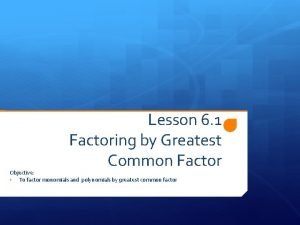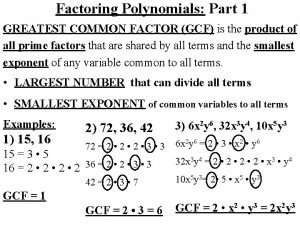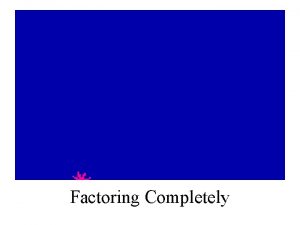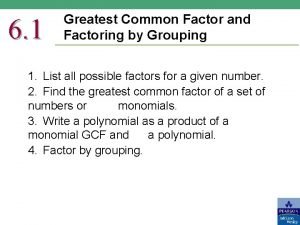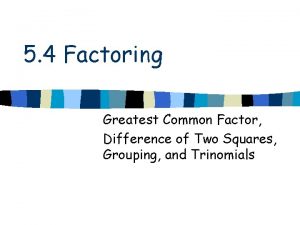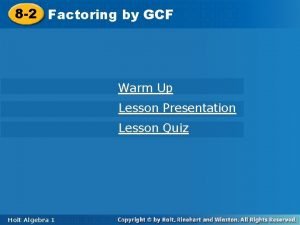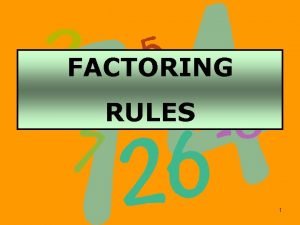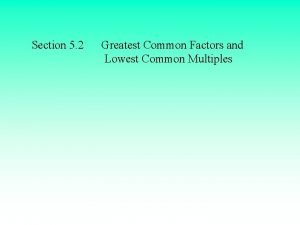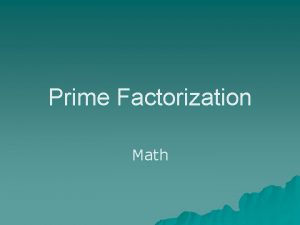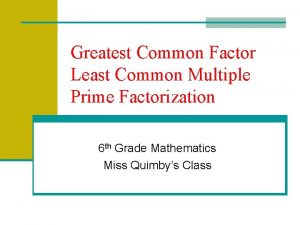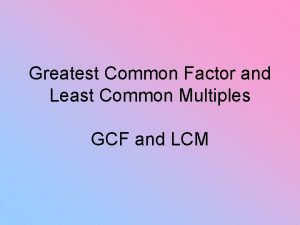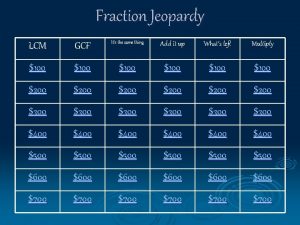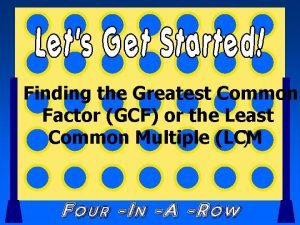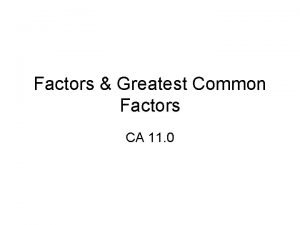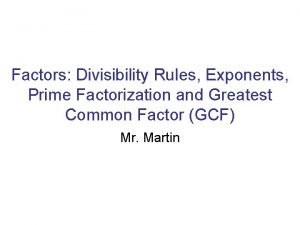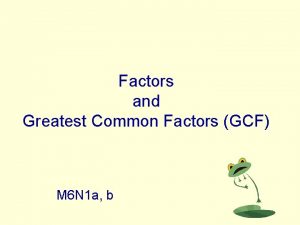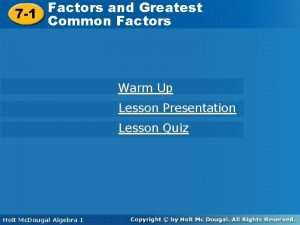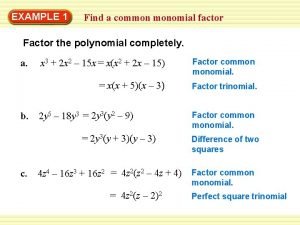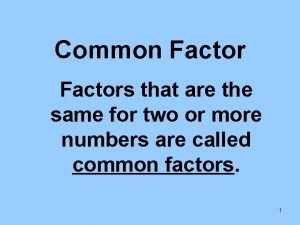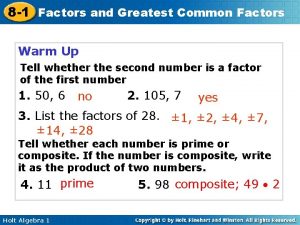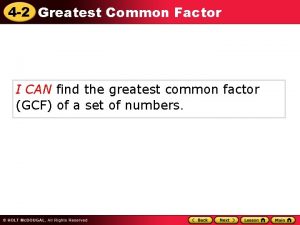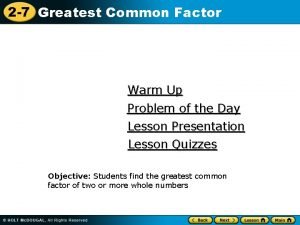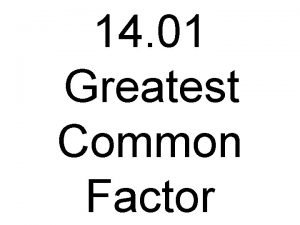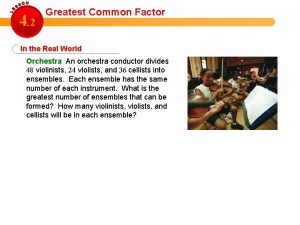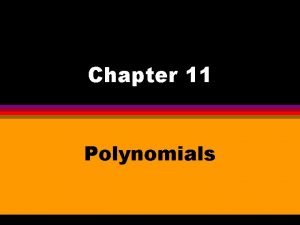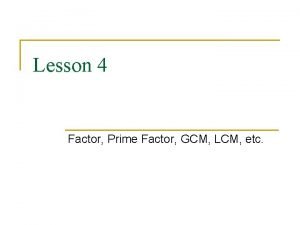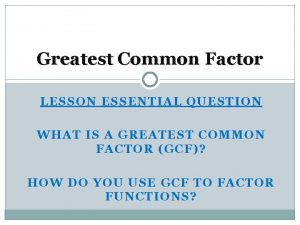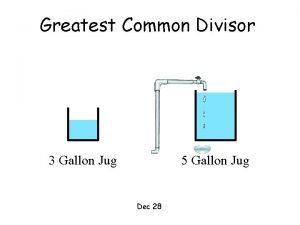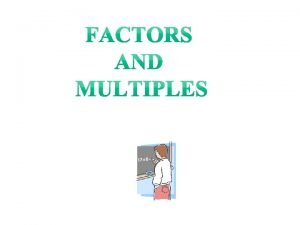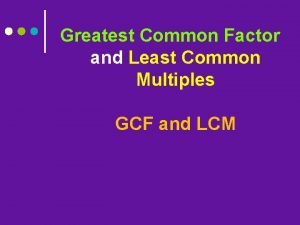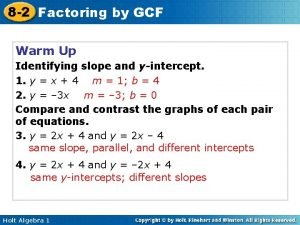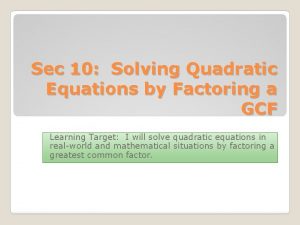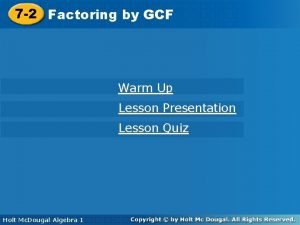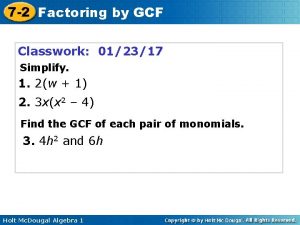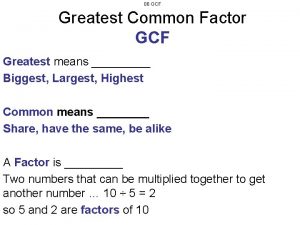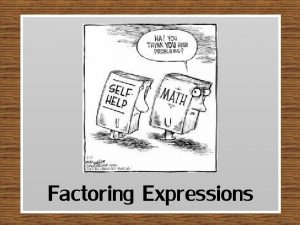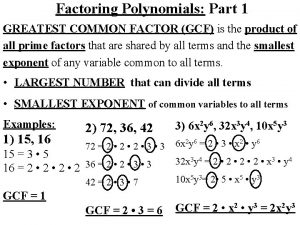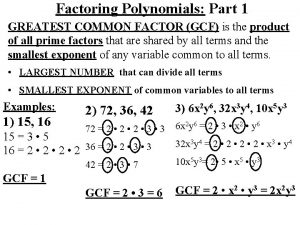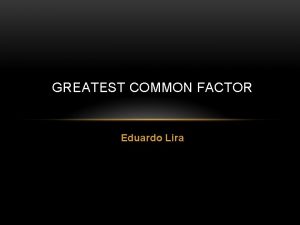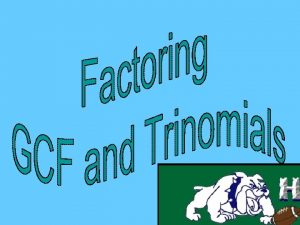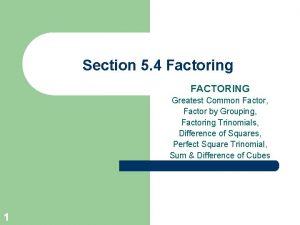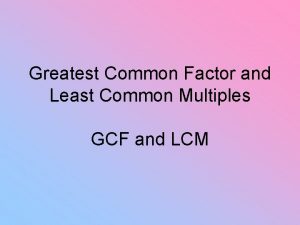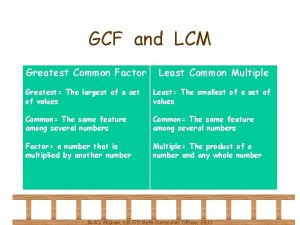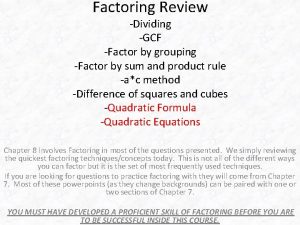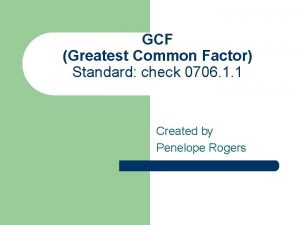FACTORING RULES 1 GCF Greatest Common Factor First















































- Slides: 47

FACTORING RULES 1

*GCF( Greatest Common Factor) – First Rule 4 TERMS Grouping 3 TERMS Perfect Square Trinomial AC Method with Grouping 2 TERMS Difference Of Two Squares Sum or Difference Of Two Cubes 2

GCF Greatest Common Factor First Rule to Always Check 3

4

5

6

4 TERMS - Grouping 7

8

3 TERMS 1) Perfect Square Trinomials 2) 2) AC Method With Grouping We will explore factoring trinomials using the ac method with grouping next and come back to Perfect Square Trinomials later. 9

Factoring Trinomials by Using The AC Method With Grouping 10

Factor the trinomial completely. The first rule of factoring is to factor out the Greatest Common Factor (GCF). 11

Stop! Check that you have factored the (GCF) correctly by distributing it back through the remaining polynomial to obtain the original trinomial. 12

After factoring out the (GCF), the remaining polynomial is of the form To factor , we must find two integers whose product is ac and whose sum is b. To factor , we must find two integers whose product is -60 and whose sum is 7. 13

FACTORS OF SUM OF FACTORS OF 14

ac = b=7 Replace b = 7 in our original expression with b = 12 + (-5). 15

FINISH FACTORING BY GROUPING 16

FACTORED COMPLETELY 17

Practice Problems 18

GCF KEY # FACTORS OF SUM OF FACTORS OF 19

GCF KEY # FACTORS OF SUM OF FACTORS OF 20

GCF KEY # FACTORS OF SUM OF FACTORS OF 21

GCF KEY # FACTORS OF SUM OF FACTORS OF 22

GCF KEY # FACTORS OF SUM OF FACTORS OF 23

GCF KEY # FACTORS OF SUM OF FACTORS OF 24

Answers To Practice Problems 25

Perfect Square Trinomials 26

27

2 TERMS 1) Difference of Two Squares 2)2) Sum and Difference of Two Cubes 28

Difference of Two Squares 29

30

Sum and Difference of Two Cubes 31

32

33

34

35

What purpose does factoring serve? Factoring is an algebraic process which allows us to solve quadratic equations pertaining to real-world applications, such as remodeling a kitchen or building a skyscraper. We will cover the concept of solving quadratic equations and then investigate some realworld applications. 36

Solving Quadratic Equations A quadratic equation is an equation that can be written in standard form where a, b, and c represent real numbers, and 37

We will solve some quadratic equations using factoring and the Zero-Factor Property. When the product of two real numbers is 0, at least one of them is 0. If a and b represent real numbers, and if then a=0 or b=0 38

Solve Each Equation 39

40

41

42

REAL-WORLD APPLICATIONS USING QUADRATIC EQUATIONS 43

44

45

The height h in feet reached by a dolphin t seconds after breaking the surface of the water is given by h How long will it take the dolphin to jump out of the water and touch the trainer’s hand? 46

From the top of the building a ball is thrown straight up with an initial velocity of 32 feet per second. The equation below gives the height s of the ball t seconds after thrown. Find the maximum height reached by the ball and the time it takes for the ball to hit the ground. 47
 Lcm of 48 and 60
Lcm of 48 and 60 Lesson 1 factoring using the greatest common factor
Lesson 1 factoring using the greatest common factor Greatest common factor polynomials
Greatest common factor polynomials Factoring with gcf
Factoring with gcf Factoring expressions
Factoring expressions Factor by greatest common factor
Factor by greatest common factor Factor out the greatest common factor
Factor out the greatest common factor Lesson 8-2 factoring by gcf
Lesson 8-2 factoring by gcf Lcm of 12 and 18
Lcm of 12 and 18 Factorization rules
Factorization rules How do you find the greatest common factor of two numbers
How do you find the greatest common factor of two numbers Gcf 84 and 56
Gcf 84 and 56 Greatest common factor of 10 and 14
Greatest common factor of 10 and 14 Greatest common factor definition
Greatest common factor definition Factors 72
Factors 72 Common factors of 12 and 24
Common factors of 12 and 24 What is the greatest common factor of 16 and 48
What is the greatest common factor of 16 and 48 Gcf of 24 and 36
Gcf of 24 and 36 Factors for 60
Factors for 60 Greatest common factor of 7 and 9
Greatest common factor of 7 and 9 Gcf of 27
Gcf of 27 What is the greatest common factor of 42 and 84
What is the greatest common factor of 42 and 84 Find the greatest common factor of each pair of monomials
Find the greatest common factor of each pair of monomials Greatest common factor with exponents
Greatest common factor with exponents Find the common factor of 12 and 24
Find the common factor of 12 and 24 Prime factors of 49
Prime factors of 49 All factors of 60
All factors of 60 Example of polynomial with common monomial factor
Example of polynomial with common monomial factor Common factors of 24 and 30
Common factors of 24 and 30 Greatest common factor of 60
Greatest common factor of 60 Gcf of 8 and 28
Gcf of 8 and 28 What are all the factors of 63
What are all the factors of 63 Gcf of 28
Gcf of 28 Multiples
Multiples Highest common factor
Highest common factor Lesson 2-1 greatest common factor
Lesson 2-1 greatest common factor Greatest common monomial factor of 5a3+a3b
Greatest common monomial factor of 5a3+a3b Greatest common factor prime factorization
Greatest common factor prime factorization Highest common factor
Highest common factor Essential questions for factoring polynomials
Essential questions for factoring polynomials 5 gallon jug 3 gallon jug
5 gallon jug 3 gallon jug What is the greatest common factor of 36 and 90
What is the greatest common factor of 36 and 90 Gcf of 24 and 60
Gcf of 24 and 60 Factor the common factor out of each expression
Factor the common factor out of each expression Solving quadratic equations by factoring gcf worksheet
Solving quadratic equations by factoring gcf worksheet Gcf factoring polynomials
Gcf factoring polynomials Factoring polynomials with gcf
Factoring polynomials with gcf 7-2 factoring by gcf answers
7-2 factoring by gcf answers

